When Will Mt Etna Erupt Again Mount Etna Last Eruption Dfghjkl
| Mountain Etna | |
|---|---|
 Etna with the city of Catania in the foreground (Dec 2007) | |
| Highest point | |
| Summit | 3,357 m (eleven,014 ft)(varies)[i] [2] |
| Prominence | 3,357 m (11,014 ft) Ranked 59th |
| Isolation | 999 km (621 mi) |
| Listing | Ultra |
| Coordinates | 37°45.3′N 14°59.vii′E / 37.7550°N 14.9950°Eastward / 37.7550; 14.9950 Coordinates: 37°45.3′N 14°59.vii′E / 37.7550°Due north 14.9950°E / 37.7550; fourteen.9950 [i] |
| Geography | |
| Mount Etna Metropolitan Metropolis of Catania in Sicily, Italy Prove map of Sicily Mount Etna Mount Etna (Italy) Show map of Italian republic | |
| Geology | |
| Age of rock | 350,000 – 500,000 years |
| Mountain type | Stratovolcano |
| Final eruption | xvi February 2022 – present [iii] |
| UNESCO World Heritage Site | |
| Criteria | Natural: eight |
| Reference | 1427 |
| Inscription | 2013 (37th Session) |
| Area | 19,237 ha |
| Buffer zone | 26,220 ha |
Mount Etna, or simply Etna (Italian: Etna [ˈɛtna] or Mongibello [mondʒiˈbɛllo]; Sicilian: Muncibbeḍḍu [mʊntʃɪbˈbɛɖɖʊ] or a Muntagna ; Latin: Aetna; Aboriginal Greek: Αἴτνα and Αἴτνη [four]), is an active stratovolcano on the e coast of Sicily, Italy, in the Metropolitan City of Catania, between the cities of Messina and Catania. Information technology lies above the convergent plate margin between the African Plate and the Eurasian Plate. It is ane of the tallest active volcanoes in Europe,[5] and the tallest peak in Italy south of the Alps with a electric current peak (July 2021) of 3,357 m (11,014 ft),[2] though this varies with height eruptions. Over a vi-month period in 2021, Etna erupted so much volcanic material that its height increased by approximately 100 feet, and the southeastern crater is now the tallest office of the volcano.[6]
Etna covers an area of 1,190 kmtwo (459 sq mi) with a basal circumference of 140 km (87 miles). This makes it by far the largest of the three active volcanoes in Italy, being about ii and a half times the height of the side by side largest, Mount Vesuvius. Only Mount Teide on Tenerife in the Canary Islands surpasses it in the whole of the European–North-African region west of the Blackness Body of water.[vii]
In Greek mythology, the mortiferous monster Typhon was trapped under this mount by Zeus, the god of the heaven and thunder and king of gods, and the forges of Hephaestus were said also to be underneath it.[8]
Mountain Etna is one of the world'southward most active volcanoes and is in an almost constant state of activity. The fertile volcanic soils back up extensive agronomics, with vineyards and orchards spread across the lower slopes of the mountain and the wide Plainly of Catania to the south.[9] Due to its history of recent activity and nearby population, Mount Etna has been designated a Decade Volcano by the United Nations.[10] In June 2013, it was added to the listing of UNESCO World Heritage Sites.[xi]

Multidirectional Hillshade relief of Mountain Etna

Etymology and folklore [edit]
One view is that the give-and-take Etna is from the Greek αἴθω (aithō), meaning "I burn down", through an iotacist pronunciation. Another view is that the name is derived from the Phoenician word attuna meaning "furnace" or "chimney".[12] In Classical Greek, it is called Αἴτνη (Aítnē),[13] a proper noun given also to Catania and the city originally known equally Inessa. In Latin information technology is called Aetna. In Arabic, it is chosen جبل النار Jabal al-Nār ('the Mountain of Fire').[14]
According to both Greek and Roman mythology, the god Vulcan (Greek: Hephaestus) had his blacksmithing forge under mountain Etna. Vulcan was the Roman god of blacksmithing. The volcano is also known as Muncibbeḍḍu in Sicilian and Mongibello or Montebello in Italian (the Italian word literally means "cute mountain"). According to some other hypothesis, the term Mongibello comes from the Latin Mulciber (qui ignem mulcet, "who placates the fire"), 1 of the Latin names of the Roman god Vulcan.[ commendation needed ] Some other theory is that Mongibello came from the Italian discussion monte plus the Arabic word jabal, both meaning "mountain."
Today, the name Mongibello is used for the area of Mount Etna containing the two central craters, and the craters located southeast and northeast of the volcanic cone.
The name Mongibel is found in Arthurian Romance, as the proper noun of the otherworld castle (or realm) of Morgan le Fay and her half-blood brother, Rex Arthur, localised at Etna, according to traditions concerning them derived from the stories told by the Breton conteurs who accompanied the Norman occupiers of Sicily. What were originally Welsh conceptions concerning a dwarf king of a paradisal, Celtic underworld became fastened to the quasi-celebrated effigy of Arthur as "Ruler of the Antipodes" and were then transplanted into a Sicilian milieu, by Bretons impressed by the already otherworldly associations of the great, volcanic mountain of their new home. Mediaevalist Roger Sherman Loomis quotes passages from the works of Gervase of Tilbury and Caesarius of Heisterbach (dating from the late twelfth century) featuring accounts of Arthur's returning of a lost horse which had strayed into his subterranean kingdom below Etna. Caesarius quotes as his authority for the story a certain canon Godescalcus of Bonn, who considered it a matter of historical fact of the fourth dimension of Emperor Henry's conquest of Sicily circa 1194. Caesarius employs in his account the Latin phrase in monte Gyber ("within Etna") to describe the location of Arthur'southward kingdom.[15] [16] [17]
The Fada de Gibel of the Castle of Gibaldar (Fairy of Etna) appears in Jaufre, the simply surviving Arthurian romance in the Occitan language, the limerick of which is dated to between 1180 and 1230. Notwithstanding, in Jaufre, while it is articulate from her name that the fairy queen in question is Morgan le Fay, the rich underworld queendom of which she is the mistress is accessed, not through a peppery grotto on the slopes of Etna, but through a 'fountain' (i.east., a spring) – a circumstance more in keeping with Morgan's original watery, rather than fiery, associations, before her incorporation into the folklore of Sicily.[18] For some other Sicilian conception of the fairy realm or castle of Morgan le Fay – encounter Fata Morgana (delusion) re. an optical miracle common in the Strait of Messina.
History of volcanic eruptions [edit]
Eruptions of Etna follow multiple patterns. Most occur at the pinnacle, where there are five distinct craters – the Northeast Crater, the Voragine, the Bocca Nuova, and 2 at the Southeast Crater Complex. Other eruptions occur on the flanks, which take more than 300 vents ranging in size from small holes in the ground to large craters hundreds of metres across. Elevation eruptions can be highly explosive and spectacular but rarely threaten the inhabited areas around the volcano. In dissimilarity, flank eruptions can occur down to a few hundred metres altitude, close to or even well within the inhabited areas. Numerous villages and pocket-size towns prevarication around or on cones of past flank eruptions. Since the year AD 1600, at least 60 flank eruptions and countless summit eruptions take occurred; virtually half of these have happened since the showtime of the 20th century. Since 2000, Etna has had four flank eruptions – in 2001, 2002–2003, 2004–2005, and 2008–2009. Elevation eruptions occurred in 2006, 2007–2008, January–Apr 2012, in July–October 2012, December 2022 and over again in February 2021.
Geological history [edit]

Mountain Etna from the south with the smoking peak in the upper left and a lateral crater in the eye
Volcanic activity first took place at Etna nigh 500,000 years ago, with eruptions occurring below the sea off the ancient coastline of Sicily.[19] Nearly 300,000 years ago, volcanism began occurring to the southwest of the top (centre top of the volcano), so activity moved towards the present centre 170,000 years agone. Eruptions at this time built up the showtime major volcanic edifice, forming a stratovolcano in alternate explosive and effusive eruptions. The growth of the mountain was occasionally interrupted past major eruptions, leading to the collapse of the pinnacle to grade calderas.
From virtually 35,000 to xv,000 years ago, Etna experienced some highly explosive eruptions, generating large pyroclastic flows, which left all-encompassing ignimbrite deposits. Ash from these eruptions has been found as far away as south of Rome's edge, 800 km (497 mi) to the north.
Thousands of years ago, the eastern flank of the mountain experienced a catastrophic plummet, generating an enormous landslide in an effect similar to that seen in the 1980 eruption of Mount St. Helens. The landslide left a big depression in the side of the volcano, known equally 'Valle del Bove' (Valley of the Ox). Enquiry published in 2006 suggested this occurred effectually 8,000 years ago, and caused a huge seismic sea wave, which left its marker in several places in the eastern Mediterranean.[twenty]
The steep walls of the valley have suffered subsequent collapses on numerous occasions. The strata exposed in the valley walls provide an of import and easily accessible tape of Etna'southward eruptive history.
The most recent collapse outcome at the acme of Etna is thought to have occurred nearly 2,000 years agone, forming what is known as the Piano Caldera. This caldera has been almost entirely filled past subsequent lava eruptions but is still visible equally a distinct break in the slope of the mount near the base of the present-day summit cone.
Mount Etna is moving towards the Mediterranean Sea at an average rate of 14 mm (0.55 in) per year, the massif sliding on an unconsolidated layer above the older sloping terrain.[21] [22]
Historical eruptions [edit]
The first known tape of eruption at Etna is that of Diodorus Siculus.[23]

An artist's impression of the 1766 eruption
In 396 BCE, an eruption of Etna reportedly thwarted the Carthaginians in their endeavor to advance on Syracuse during the 2nd Sicilian War.
A particularly violent explosive (Plinian) summit eruption occurred in 122 BCE, and caused heavy tephra falls to the southeast, including the town of Catania, where many roofs complanate.[24] To help with reconstruction after the devastating furnishings of the eruption, the Roman government exempted the population of Catania from paying taxes for ten years.[ citation needed ]
The Roman poet Virgil gave what was probably a beginning-manus description of an eruption in the Aeneid.[25]
During the first 1500 years CE, many eruptions went unrecorded (or records take been lost); amid the more than pregnant are: (1) an eruption in well-nigh 1030 CE about Monte Ilice on the lower southeast flank, which produced a lava flow that travelled about x km, reaching the sea due north of Acireale; the villages of Santa Tecla and Stazzo are built on the broad delta congenital past this lava period into the ocean; (two) an eruption in nigh 1160 (or 1224), from a fissure at only 350–450 thou (i,148–1,476 ft) elevation on the south-southeast flank almost the hamlet of Mascalucia, whose lava flow reached the body of water just to the n of Catania, in the expanse now occupied by the portion of the city named Ognina.[ citation needed ]
Rabban Bar Sauma, a Chinese traveller to the West, recorded the eruption of Etna on 18 June 1287.[26]
The 1669 eruption, Etna's virtually destructive since 122 BCE, started on eleven March 1669 and produced lava flows that destroyed at to the lowest degree 10 villages on its southern flank earlier reaching the city walls of the town of Catania five weeks later, on fifteen April. The lava was largely diverted by these walls into the sea to the s of the city, filling the harbour of Catania. A small portion of lava eventually bankrupt through a fragile section of the city walls on the western side of Catania and destroyed a few buildings earlier stopping in the rear of the Benedictine monastery, without reaching the centre of the boondocks. Contrary to widespread reports of up to xv,000 (or even 20,000) man fatalities acquired by the lava,[27] contemporaneous accounts written both in Italian and English[28] mention no deaths related to the 1669 eruption (but give very precise figures of the number of buildings destroyed, the surface area of cultivated land lost, and the economic damage). Therefore, it is uncertain where the enormous number of fatalities can be attributed. One possibility is defoliation between this eruption and an earthquake that devastated southeast Sicily (including Catania) 24 years later in 1693. A written report on the damage and fatalities acquired by eruptions of Etna in historical times reveals that only 77 human deaths are attributable with certainty to eruptions of Etna, about recently in 1987 when two tourists were killed past a sudden explosion virtually the summit.[29] [xxx]
Since 1750, 7 of Etna's eruptions have had durations of more than 5 years, more than whatsoever other volcano except Vesuvius.[31]
Modern-day eruptions (1928–nowadays day) [edit]
Equally "Europe's most agile volcano",[32] eruptions occur oftentimes (with as many as 16 eruptions taking place in 2001 [32]). However, several eruptions of notation have occurred over the last century.
Video of Etna's Nov 2013 eruption
A large lava menstruation from an eruption in 1928 led to the devastation of a population middle for the offset fourth dimension since the 1669 eruption. The eruption started high on Etna's northeast flank on two November. Then new eruptive fissures opened at decreasing elevations downwardly the flank of the volcano. The third and most vigorous of these fissures opened belatedly on 4 Nov at an unusually depression elevation, approximately ane,200 m (3,937 ft) higher up sea-level, in a zone known as Ripe della Naca. The village of Mascali, lying downwardly-gradient of the Ripe della Naca, was most completely destroyed in two days. But a church and a few surrounding buildings survived in the north part of the village, called Sant'Antonino or "il quartiere". During the last days of the eruption, the menstruum interrupted the Messina-Catania railway line and destroyed the train station of Mascali. The effect was used by Benito Mussolini's fascist government for propaganda purposes, with the evacuation, aid, and rebuilding operations beingness presented as models of fascist planning. Mascali was rebuilt on a new site, and its church building contains the Italian fascist symbol of the torch, placed above the statue of Jesus Christ.[33]
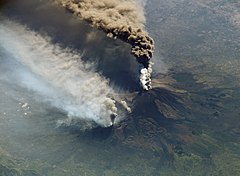
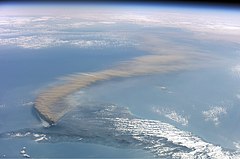
Etna's 2002 eruption, photographed from the ISS

Long exposure prototype of a "dual-vent" eruption from Mount Etna's NSEC (New S East Crater)
Other major 20th-century eruptions occurred in 1949, 1971, 1979, 1981, 1983 and 1991–1993. In 1971, lava buried the Etna Observatory (built in the late 19th century), destroyed the first generation of the Etna cable-car, and seriously threatened several small villages on Etna'south eastward flank. In March 1981, the town of Randazzo on the northwestern flank of Etna narrowly escaped destruction by unusually fast-moving lava flows. That eruption was remarkably similar to one in 1928 that destroyed Mascali. The 1991–1993 eruption saw the boondocks of Zafferana threatened by a lava flow, but successful diversion efforts saved the boondocks with the loss of merely one building a few hundred metres from the town's margin. Initially, such efforts consisted of the structure of world barriers built perpendicularly to the menses direction; it was hoped that the eruption would stop before the artificial basins created behind the barriers would be completely filled. Instead, the eruption continued, and lava surmounted the barriers, heading directly toward Zafferana. Engineers and then decided to use explosives near the source of the lava flow, to disrupt a very efficient lava tube system through which the lava travelled for up to seven km (4 mi) without losing significant heat or fluidity. The chief explosion on 23 May 1992 destroyed the tube and forced the lava into a new artificial channel, far from Zafferana, and it would have taken months to re-establish a long lava tube. Soon after the blasting, the rate of lava emission dropped, and during the remainder of the eruption (until 30 March 1993) the lava never avant-garde shut to the boondocks again.[34]
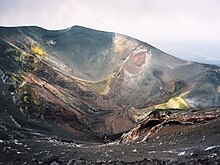
A lateral crater of the 2002–2003 eruption near the Torre del Filosofo, about 450 m (1,480 ft) beneath Etna'due south summit

House destroyed by lava on the slopes of Etna
Post-obit 6 years (1995–2001) of unusually intense activity at the four top craters of Etna, the volcano produced its get-go flank eruption since 1991–1993 in July–August 2001. This eruption, which involved activity from seven distinct eruptive fissures mostly on the south gradient of the volcano, was well covered by the mass-media considering it occurred at the height of the tourist season and numerous reporters and journalists were already in Italian republic to encompass the G8 summit in Genoa. It as well occurred close to ane of the tourist areas on the volcano, and thus was easily accessible. Part of the "Etna Sud" tourist area, including the arrival station of the Etna cable car, were damaged by this eruption, which otherwise was a rather modest-sized event by Etna standards.
In 2002–2003, a much larger eruption threw upwardly a huge column of ash that could easily be seen from space and fell as far away as Libya, 600 km (370 mi) south beyond the Mediterranean Ocean. Seismic activity in this eruption caused the eastern flanks of the volcano to sideslip by upwards to two metres, and many houses on the flanks of the volcano experienced structural damage. The eruption also completely destroyed the tourist station Piano Provenzana, on the northeastern flank of the volcano, and part of the tourist station "Etna Sud" around the Rifugio Sapienza on the south flank. Footage from the eruptions was recorded past Lucasfilm and integrated into the landscape of the planet Mustafar in the 2005 film Star Wars: Episode III – Revenge of the Sith.[35] The Rifugio Sapienza is near the site of a cable car station which had previously been destroyed in the 1983 eruption; it has now been rebuilt. Following a slow and not-destructive lava outflow on the upper southeastern flank between September 2004 and March 2005, intense eruptions occurred at the Southeast Crater in July–December 2006. These were followed by four episodes of lava fountaining, once more at the Southeast Crater, on 29 March xi April 29 April and 7 May 2007. Ash emissions and Strombolian explosions started from a vent on the eastern side of the Southeast Crater in mid-August 2007.
On 4 September 2007, a major episode of lava fountaining occurred from the new vent on the east side of the Southeast Crater, too producing a plumage of ash and scoriae which fell over the east flank of the volcano. A lava menses travelled about 4.5 km (ii.8 mi) into the uninhabited Valle del Bove. This eruption was visible far into the plains of Sicily, ending the post-obit morn between the hours of v to seven a.one thousand. local fourth dimension. Catania-Fontanarossa Airport close downward operations during the nighttime for safety precautions.[ verification needed ]
An eruption on the morning of thirteen May 2008, immediately to the east of Etna's top craters was accompanied by a swarm of more than 200 earthquakes and pregnant ground deformation in the height area. The eruption continued at a slowly diminishing rate for 417 days, until 6 July 2009, making this the longest flank eruption of Etna since the 1991–1993 eruption that lasted 473 days. Previous eruptions, in 2001, 2002–2003, and 2004–2005 had lasted 3 weeks, 3 months, and 6 months, respectively. Lava flows avant-garde 6.5 km during the first few days of this eruption but thereafter stagnated at many minor distances from the vents; during the last months of the eruption lava rarely advanced more than than 1 km downslope.
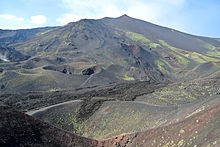
Southern flank of Mount Etna showing lateral cones and catamenia from the eruption of 2001.
Through January 2011 to February 2012, the summit craters of Etna were the site of intense activity. Frequent eruptions and ash columns forced the authorities to shut down the Catania airport on several occasions. [36] [37] [38] [39] [40] [41] The July 2011 episode too endangered the Sapienza Refuge, the main tourist hub on the volcano, only the lava flow was successfully diverted.[ citation needed ] In 2014, a flank eruption started involving lava flows and strombolian eruptions. This was the beginning flank eruption since 2008–09 [42]
On 3 December 2015, an eruption occurred which climaxed between 03:20 and 04:10 local fourth dimension. The Voragine crater exhibited a lava fountain which reached 1 km (three,300 ft) in pinnacle, with an ash feather which reached 3 km (ix,800 ft) in height.[43] [44] The activeness continued on the following days, with an ash plume that reached vii km (23,000 ft) in height that forced Catania airport to shut down for a few hours.[45] Volcanic gas emissions from this volcano are measured by a multi-component gas analyzer system, which detects pre-eruptive degassing of rise magmas, improving prediction of volcanic activeness.[46]
An eruption on 16 March 2022 injured 10 people, including a BBC News goggle box crew, later on magma exploded upon contact with snow.[47] [48]
An eruption on 24 December 2018, post-obit a dyke intrusion at shallow depth, spewed ash into the air, forcing the closure of airspace effectually Mount Etna. Ii days later on, a magnitude 4.nine earthquake shook the boondocks of Fleri and surrounding towns and hamlets in the Province of Catania, damaging buildings and injuring iv people.[49] [l]
Beginning in Feb 2021, Mountain Etna began a series of explosive eruptions, which have had an impact on nearby villages and cities, with volcanic ash and rock falling equally far away as Catania. As of 12 March 2021[update], the volcano has erupted 11 times in three weeks.[51] The eruptions have consistently sent ash clouds over 10 km (33,000 ft) into the air, endmost Sicilian airports. At that place have been no reports of injuries.[ needs update ]
The most recent major eruption occurred on xi February 2022.[52] [53]
Volcanic explosivity index of recent eruptions [edit]
The Global Volcanism Programme has assigned a Volcanic Explosivity Index (VEI) to all of Mount Etna'due south eruptions since January 1955:[54]
| VEI | Number of eruptions (full=49) |
|---|---|
| VEI 0 | 1 |
| VEI 1 | 17 |
| VEI 2 | 24 |
| VEI three | 7 |
Smoke rings [edit]

Map of municipalities in the province of Catania.
In the 1970s Etna erupted fume rings,[55] 1 of the showtime captured events of this blazon, which are extremely rare. This happened over again in 2000.[56] Video footage of 8 June 2000 event was captured.[57] [58] Another event occurred on xi April 2013.[59]
Geopolitical boundaries [edit]
The borders of ten municipalities (Adrano, Biancavilla, Belpasso, Bronte (from two sides), Castiglione di Sicilia, Maletto, Nicolosi, Randazzo, Sant'Alfio, Zafferana Etnea) meet on the summit of Mount Etna, making this a multipoint of elevenfold complexity.
Facilities [edit]
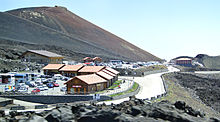
Sapienza Refuge, the main tourist hub.

Etna is one of Sicily's primary tourist attractions, with thousands of visitors every yr.[60] The most common road is through the route leading to Sapienza Refuge ski area, lying at the south of the crater at elevation of 1910 g.[61] From the Refuge, a cableway runs uphill to an elevation of 2500 1000, from where the crater area at 2920 m is attainable.[62]
Ferrovia Circumetnea – Round-Etna railway – is a narrow-gauge railway synthetic between 1889 and 1895. It runs around the volcano in a 110-km long semi-circle starting in Catania and ending in Riposto 28 km north of Catania.
There are two ski resorts on Etna: 1 at the Sapienza Refuge, with a chairlift and three ski lifts, and a smaller 1 on the north, at Piano Provenzana near Linguaglossa, with iii lifts and a chairlift.[63]
Sapienza Refuge was the terminate of Stage nine of the 2011 Giro d'Italia and Stage four of the 2022 Giro.
See also [edit]
- Genista aetnensis, the Mount Etna broom
- List of Italian regions by highest signal
- Listing of volcanoes in Italy
- Mount Vesuvius
- Sacred mountains
- Volcanic Seven Summits
Notes [edit]
- ^ a b The superlative varies with volcanic activeness. The volcano concluding erupted in August 2021. It is frequently given as 3,350 m (x,990 ft), but many sources that back up this concede that this is approximate. The coordinates given, which are consequent with SRTM data, are from a 2005 GPS survey. The pinnacle data are based on a LIDAR (Light Detection and Ranging) survey carried out in June 2007, see Neri, M.; et al. (2008), "The irresolute face up of Mountain Etna's summit expanse documented with Lidar technology", Geophysical Research Messages, 35 (9): L09305, Bibcode:2008GeoRL..3509305N, doi:10.1029/2008GL033740
- ^ a b Pezzella, Francesca. "L'Etna si supera. Nuovo tape di altezza a 3357 metri". www.ingv.it (in Italian). Retrieved x August 2021.
- ^ "Mount Etna Volcano, Italy: Map, Facts, Eruption Pictures". geology.com.
- ^ Suda, alphaiota, 375
- ^ "Etna & Aeolian Islands 2012 – Cambridge Volcanology". www.volcano.group.cam.air-conditioning.uk.
- ^ Laura Geggel (sixteen Baronial 2021). "Mountain Etna is 100 anxiety taller than it was vi months ago". Space.com.
- ^ "Italy volcanoes and Volcanics". USGS. Archived from the original on 11 July 2011.
- ^ Aelian, Hist. An. xi. three, referenced under Aetnaeus in William Smith's Dictionary of Greek and Roman Biography and Mythology
- ^ Thomaidis, Konstantinos; Troll, Valentin R.; Deegan, Frances Chiliad.; Freda, Carmela; Corsaro, Rosa A.; Behncke, Boris; Rafailidis, Savvas (2021). "A message from the 'surreptitious forge of the gods': history and current eruptions at Mt Etna". Geology Today. 37 (four): 141–149. doi:ten.1111/gto.12362. ISSN 1365-2451. S2CID 238802288.
- ^ "Decade Volcanoes". U.s. Geological Survey.
- ^ Mount Etna Becomes a Globe Heritage Site, Italy Magazine, 4 May 2013
- ^ According to Adrian Room's volume Identify-names of the World, the name "Etna" originated from the Phoenician give-and-take attuna meaning "furnace" or "chimney". He dismisses the hypothesis that 'Etna' has a Greek derivation. "Volcano – Podictionary Discussion of the Day". Blog.oup.com. 29 Apr 2010. Retrieved two June 2011.
- ^ "Woodhouse's English language-Greek Dictionary Page Epitome". Artflx.uchicago.edu. Retrieved 2 June 2011.
- ^ Chevedden, Paul E. (2010), "A Crusade from the Kickoff: The Norman Conquest of Islamic Sicily, 1060–1091", Al-Masaq: Islam and the Medieval Mediterranean, 22 (2): 191, doi:ten.1080/09503110.2010.488891, S2CID 162316105
- ^ Bruce, Christopher W. (1999). The Arthurian Name Lexicon. Taylor & Francis. ISBN 0-8153-2865-six.
- ^ Loomis, Roger Sherman Wales and the Arthurian Fable, pub. University of Wales Printing, Cardiff 1956 and reprinted by Folcroft Press 1973, Affiliate five Rex Arthur and the Antipodes, pp. lxx–71.
- ^ Loomis, Roger Sherman, Arthurian Tradition And Chrétien de Troyes pub. Columbia University Press, New York 1948, pp. 66 & 306.
- ^ Arthurian Literature in the Middle Ages: A Collaborative History ed. Roger Sherman Loomis, pub. Oxford University Printing 1959, special edition for Sandpiper Books Ltd. 2001, ISBN 0 19 811588 1
- ^ Martin-Schutz, Alicia. "Mt. Etna".
- ^ It has been suggested that this was the reason why the settlement of Atlit Yam (State of israel), now below sea level, was all of a sudden abandoned effectually that time. Encounter Pareschi, M. T.; Boschi, East. & Favalli, M. (2007), "Holocene tsunamis from Mountain Etna and the fate of Israeli Neolithic communities", Geophysical Research Messages, 34 (16): L16317, Bibcode:2007GeoRL..3416317P, doi:10.1029/2007GL030717 . This claim has been contested, however, equally "there is no prove of tsunami deposits, nor of sudden and catastrophic changes such as damaged structures, whole animal carcases or evidence of traumatic injury, such as might exist expected to outcome from a tsunami event" (Galili E., Rosen B., Evron M.W., Hershkovitz I., Eshed V., Horwitz 50.K. (2020) Israel: Submerged Prehistoric Sites and Settlements on the Mediterranean Coastline—the Current State of the Art. In: Bailey G., Galanidou N., Peeters H., Jöns H., Mennenga M. (eds) The Archeology of Europe's Drowned Landscapes. Coastal Enquiry Library, vol 35. Springer, Cham). Encounter also, Galili, E., Horwitz, L. K., Hershkovitz, I., Eshed, V., Salamon, A., Zviely, D., Weinstein‐Evron, M., and Greenfield, H. (2008), Comment on "Holocene tsunamis from Mount Etna and the fate of Israeli Neolithic communities" by Maria Teresa Pareschi, Enzo Boschi, and Massimiliano Favalli, Geophysical Research Messages, 35, L08311.
- ^ Murray, J.B.; van Wyk de Vries, B.; Pitty, A. (April 2018). "Gravitational sliding of the Mt. Etna massif along a sloping basement" (PDF). Bulletin of Volcanology. lxxx (4): forty. Bibcode:2018BVol...fourscore...40M. doi:ten.1007/s00445-018-1209-ane. PMC6560784. PMID 31258237.
- ^ Gravitational collapse of Mount Etna's southeastern flank
- ^ Tanguy, J. C.; Condomines, Thou.; Goff, M.; Chillemi, Five.; Delfa, Due south.; Patanè, K. (2007). "Mount Etna eruptions of the last 2,750 years: Revised chronology and location through archeomagnetic and 226Ra-230Th dating" (PDF). Bulletin of Volcanology. 70 (1): 55. Bibcode:2007BVol...70...55T. doi:10.1007/s00445-007-0121-ten. S2CID 44241302.
- ^ Coltelli, Thou.; Del Carlo, P. & Vezzoli, L. (1998), "Discovery of a Plinian basaltic eruption of Roman historic period at Etna Volcano, Italia", Geology, 26 (12): 1095–1098, Bibcode:1998Geo....26.1095C, doi:x.1130/0091-7613(1998)026<1095:DOAPBE>two.3.CO;2
- ^ Aeneid, edition of Theodore C. Williams, ca. 1908 [book Three, lines 569–579]
- ^ The history of the life and travels of Rabban Sawma
- ^ "Mount Etna (volcano, Italy)". (the Encyclopædia Britannica has been wrongly cited as ane source of this faux information).
- ^ The Encyclopaedia Britannica 5th edition (1817) quotes from the eyewitness report of Lord Winchelsea, Administrator to Constantinople, to the Court of England. It happens not to mention casualties. Encyclopaedia Britannica: Or, A Dictionary of Arts, Sciences, and Miscellaneous Literature, Enlarged and Improved. Vol. 1 (5th ed.). Edinburgh: A. Lawman. 1823. pp. 248–249. See as well: Charles Hutton; Georges Shaw; Richard Pearson (1809). The Philosophical Transactions of the Regal Society of London, from Their Commencement, in 1665, to the Yr 1800; Abridged...: From 1665 to 1672. 1. London. pp. 357–358, 383–387, 637–638.
- ^ "Eruption of Snow-Covered Mt. Etna Kills 2 Tourists and Injures 7 Others". LA Times . Retrieved ii June 2019.
- ^ "Etna and Man". Boris.vulcanoetna.it. Archived from the original on 22 July 2011. Retrieved 2 June 2011.
- ^ Venzke, Due east., ed. (x December 2020). "What volcanoes have had the longest eruptions?". Global Volcanism Program — Volcanoes of the World (Version 4.nine.ii). Smithsonian Institution. doi:10.5479/si.GVP.VOTW4-2013. Retrieved xv December 2020.
- ^ a b "The Continuing Eruption of Mt. Etna". Earthobservatory.nasa.gov. 23 July 2001. Retrieved 15 February 2022.
- ^ Duncan, A.M.; Dibben, C.; Chester, D.K.; Invitee, J.Due east. (1996). "The 1928 Eruption of Mountain Etna Volcano, Sicily, and the Destruction of the Boondocks of Mascali". Disasters. twenty (one): i–20. doi:x.1111/j.1467-7717.1996.tb00511.x. PMID 8867507.
- ^ Barberi, F.; Carapezza, M. L.; Valenza, M.; Villari, L. (1993), "The control of lava menstruum during the 1991–1992 eruption of Mt. Etna", Journal of Volcanology and Geothermal Enquiry, 56 (1–ii): 1–34, Bibcode:1993JVGR...56....1B, doi:10.1016/0377-0273(93)90048-Five
- ^ "press_text_booklet.indd" (PDF) . Retrieved ii June 2011.
- ^ "Italia's Mt Etna erupts – WORLD News".
- ^ Ken Kremer (15 January 2011). "Spectacular Eruptions of Mt. Etna in Sicily from Space and Earth". Universetoday.com . Retrieved 2 June 2011.
- ^ "There she blows! Stunning images of Mountain Etna eruption", Mirror, nine February 2012
- ^ Eruption of Mt. Etna closes airport in Catania, Agi.it, 23 October 2011
- ^ "INGV – Etna Observatory". Ct.ingv.it. Retrieved 2 June 2011.
- ^ "BBC News – Footage shows Mount Etna spewing lava and ash". Bbc.co.united kingdom of great britain and northern ireland. 12 May 2011. Retrieved 2 June 2011.
- ^ "Etna Volcano (Italia): Eruption Update & Current Activity". Volcanodiscovery.com. 10 February 2022. Retrieved 15 February 2022.
- ^ Klemetti, Erik (3 December 2015). "Italian republic'due south Etna Unleashes a Short only Spectacular Eruption". Wired . Retrieved 3 December 2015.
- ^ "Etna volcano – eruption update". Volcano Discovery. 3 December 2015. Retrieved 3 December 2015.
- ^ "Etna prove, nuova fontana di lava: non-si ferma l'emissione di cenere". Corriere della Sera (in Italian). iv December 2015. Retrieved 5 December 2015.
- ^ Aiuppa, Alessandro; Moretti, Roberto; Federico, Cinzia; Giudice, Gaetano; Gurrieri, Sergio; Liuzzo, Marco; Papale, Paolo; Shinohara, Hiroshi; Valenza, Mariano (1 December 2008). "Forecasting Etna eruptions by real-time observation of volcanic gas composition". Geology. 35 (12): 1115. Bibcode:2007Geo....35.1115A. doi:ten.1130/G24149A.one.
- ^ Balmer, Crispian (16 March 2017). "Volcanic explosion on Mount Etna injures 10 people". Reuters . Retrieved sixteen March 2017.
- ^ "Mount Etna: BBC coiffure defenseless up in volcano blast". BBC News. 16 March 2017. Retrieved 16 March 2017.
- ^ "Mountain Etna: 4.8-magnitude earthquake jolts Sicily". The Guardian. Rome. Agence French republic-Presse. 26 Dec 2018. Retrieved 26 December 2018.
- ^ "Terremoto four km NE Viagrande (CT), Magnitudo Mw iv.ix, 26 dicembre 2022 ore 03:19:14 (Fuso Orario Italy) » INGV Centro Nazionale Terremoti". cnt.rm.ingv.it . Retrieved 23 March 2019.
- ^ Bonaccorso, Nicole (10 March 2021). "Mount Etna Erupts for the 11th Time in Three Weeks (PHOTOS)". The Conditions Aqueduct. Retrieved 14 March 2022.
- ^ "Etna spews fume and ashes in spectacular new eruption". France24. 16 February 2021. Retrieved 22 February 2021.
- ^ Washington Post Staff (xi February 2022). "Mount Etna volcano in Italian republic puts on spectacular show". The Washington Postal service . Retrieved 11 Feb 2022.
- ^ "Etna: Eruptive History". Global Volcanism Program. Smithsonian Institution. Retrieved 26 June 2021.
- ^ "SwissEduc – Stromboli online – Etna 2000". www.stromboli.cyberspace.
- ^ "Etna hoops it up". BBC News. 31 March 2000. Retrieved 9 October 2008.
- ^ "Erupting Mt. Etna coughs up a smoke band". WJLA (ABC) Storm Sentry 7. sixteen August 2011. Retrieved fifteen Apr 2013.
- ^ Geoff, Mackley. "Mt Etna – Sicily, Italy – the greatest testify on earth !". Geoff Mackley. Retrieved 15 April 2013.
- ^ "Mount Etna blows smoke rings during volcanic eruptions". NBC News. 12 April 2013. Retrieved xv April 2013.
- ^ Etna National Park, Italia, National Geographic Travel, eight April 2011
- ^ Rifugio Sapienza: who nosotros are, archived from the original on 26 March 2013
- ^ Funivia dell'Etna, Lonely Planet
- ^ "Skiing Mount Etna: Hitting the slopes 1 day, sheet the next", Telegraph, 12 March 2010
References [edit]
- "Etna". Global Volcanism Program. Smithsonian Institution. Retrieved 25 December 2008.
- Chester, D. G.; Duncan, A. K.; Guest, J. E.; Kilburn, C. R. J. (1985). Mount Etna: The Beefcake of a Volcano. Chapman and Hall. pp. 412 pp. ISBN978-0-8047-1308-5.
External links [edit]
| | Wikimedia Commons has media related to Etna. |
- Mount Etna Nord Live Webcams by Linguaglossa H24
- "VONA bulletin".
- Mount Etna Regional Park
- Youtube video: eruption phases of Etna in 2022 (in Italian)
- Smithsonian Establishment: Global Volcanism Program: Etna
- Footage of the 1971 eruption is featured in the 1979 picture Days of Fury, hosted past Vincent Toll
Source: https://en.wikipedia.org/wiki/Mount_Etna
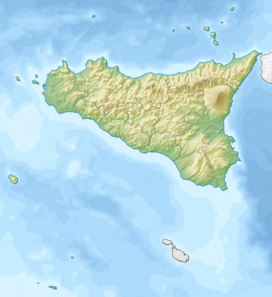

0 Response to "When Will Mt Etna Erupt Again Mount Etna Last Eruption Dfghjkl"
Post a Comment